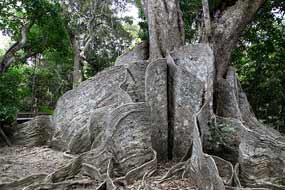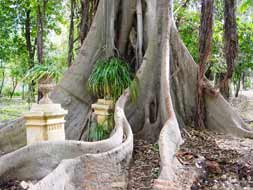News and Site Updates Archive 2010/01/15
I think Haiti is a place that suffers so much from neglect that people only want to hear about it when It's at its extreme.
And that's what they end up knowing about it.
- Edwidge Danticat
15 Jan '10 -
 |
Paul Farmer, American anthropologist and physician, Presley Professor of Medical Anthropology at Harvard University and an
attending physician at Brigham and Women's Hospital in Boston, was last year named chairman of Harvard Medical School's Department of Global Health and Social Medicine. He currently lives in
Kigali, Rwanda and is one of the founders of Partners In Health (PIH), an international health and social justice organisation, which happens to provide free treatment to patients in
Haiti. Dr Farmer was named United Nations Deputy Special Envoy to Haiti to assist in improving economic and social conditions there and mentioned as possible nominee to head the US Agency for
International Development (USAID). However, this was reportedly blocked by the White House. Why? Farmer has overseen projects in Russia, Rwanda, Lesotho, Malawi and Peru and is
co-founder and Board Member of the Institute for Justice & Democracy in Haiti. USAID is helping Haiti after the earthquake, but not under the direction of Dr
Farmer. Secretary of State Hillary Clinton sought White House permission to announce
Farmer as a candidate to lead USAID, but said she wasn't given the nod. Farmer was said to have been daunted by the vetting paperwork for the prospective job, including a form requiring
him to list every foreigner he had come into contact with over the past several years. The new head of the agency, Rajiv Shah, an agricultural researcher from Coast Rica, took office 6
days before the quake. |
 |
"In order to promote their patented drugs and vaccines against flu, pharmaceutical companies influenced scientists and official agencies responsible for public health standards to alarm governments
worldwide and make them squander tight health resources for inefficient vaccine strategies, needlessly exposing millions of healthy people to the risk of unknown side effects of insufficiently
tested vaccines. The bird flu campaign (2005/06) combined with the swine flu campaign seem to have caused a great deal of damage, not only to some vaccinated patients and to public
health-budgets, but to the credibility and accountability of international health agencies. The Council of Europe and member-states should ask for immediate investigations and consequences on
national levels as well as on the international level. The definition of 'alarming pandemic' must not be under the influence of drug-sellers. WHO, in cooperation with some big
pharmaceutical companies and their scientists, redefined pandemic and lowered the alarm threshold. Those new standards forced politicians in most states to react immediately, to sign marketing
commitments for additional and new vaccines against swine flu, and to spend billions to catch up with the alarming scenario that Big Pharma, media and WHO were spreading." - Dr Wolfgang Wodarg, Chairman of the Health Committee in the European Council of the European Union (signed and supported by members of the
Parliamentary Assembly of the Council of Europe). France is looking to sell millions of surplus vaccines for
the H1N1 flu strain after ordering many millions more shots than actually needed. |
 |
Fouad al-Rabiah was a Kuwaiti prisoner ordered released by US Courts after
revelations that the US government tortured this innocent man to extract false confessions then threatened him until he obligingly repeated those lies as if they were true. Al-Rabiah, 42-year
old father of 4, had no history of involvement with militancy or terrorism; instead, he spent 20 years at a management desk job at Kuwait Airways, had ownership interest in health clubs, and a
history of legitimate refugee relief work, taking a 6-month approved leave of absence from work in 1994 - 95 to do relief work in Bosnia and going to Bangladesh in 2000 to deliver kidney dialysis
fluid to a hospital in Dhaka. A trial attorney with the Department of Justice, familiar with the al-Rabiah case though not assigned to it, said, "The conclusion drawn by my colleagues – some of whom are liberal Democrats, some
conservative law-and-order Republicans – is to a person that the detention and interrogation programmes the US implemented in the months and years following 9/11 were a complete abrogation and
violation of international law and, in many cases, federal law. They are also fundamentally immoral. We agree the al-Rabiah case is by far the most egregious yet to come to light
but there may be other, worse cases. The most horrifying passage from the Court’s decision was something said to al-Rabiah during his interrogation: 'There is nothing against
you. But there is no innocent person here. So, you should confess to something so you can be charged and sentenced and serve your sentence and then go back to your family and country,
because you will not leave this place innocent.' This was an agent of the United States saying this, not something pulled from transcripts of the Nuremburg trials, nor taken from reports of
Stalin’s gulags. The enormity is nearly incomprehensible. But far worse is the fact that the government nevertheless sought to convict based on the resulting confession." |
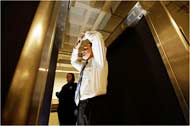 |
The plan for broad use of X-ray body scanners to detect bombs/weapons under airline passengers’ clothes has rekindled a debate about the safety of delivering small doses of radiation to millions of people — a process some experts think may cause a
few additional cancer deaths. Full-body scanners already in place in some airports use a different type of imaging technology, millimetre wave, utilising less-powerful non-ionizing
radiation. It doesn't pose the same risks - but those machines produce images that are less clear. So, in the wake of the attempted bombing of an airplane travelling to Detroit from
Amsterdam on 25 December, the US has turned to backscatter scanners for routine security checks. Congress appropriated funds for 450 scanners to be placed in American airports. Most
discussion about full-body scanners focuses on privacy issues surrounding the resulting nude images. The American Civil Liberties Union denounced the practice as a virtual strip
search. Backscatter scanners work by shooting X-ray beams at a subject - but rather than making an image from what passes through (as a doctor’s diagnostic X-ray machine does) they measure
what bounces back, producing images of passengers without clothing. The ionizing radiation is powerful enough to strip the body's molecules of electrons, creating charged particles that cause
cell damage and perhaps cancer. |
|
 |
This image (from 2002) shows remarkable and mysterious details near the dark central region of a planet-sized sunspot from the
surface of the sun. The picture was made using the Swedish Solar Telescope now in operation on the Canary Island of La Palma. Along with features described as hairs and canals are dark
cores visible within the bright filaments that extend into the sunspot, representing previously unknown and unexplored solar phenomena. The filaments' newly revealed dark cores are thousands of
kilometres long but only about 100 kilometres wide. |
 |
Astronomers have identified a ticking time-bomb in space that lies perilously close to Earth. The star, called T Pyxidis, looks set to explode as a supernova with the force of 20 billion billion billion
megatons of TNT. But as it lies nearly 3,260 light-years away in our own galaxy, that's close enough in cosmic terms for a blast to possibly devastate our planet. A thermonuclear explosion
at such a close distance will "fry Earth", dumping as much gamma ray energy as 1,000 solar flares at once and stripping away the ozone layer thus allowing deadly radiation to bombard all
life. The star will then become as bright as all other stars in the galaxy put together and shine like a beacon halfway across the universe. This catastrophic event, called a Type Ia
supernova, will release 10 million times more energy than a normal nova. The astronomers' news release suggests it'll happen soon, but when pressed, "soon" turns out to be sometime within the
next 10 million years. And if you care, a light year is 9 trillion, 460 billion, 730 million, 472 thousand, 580 point 8 kilometres (9,460,730,472,580.8) or 5,878,630,000,000 miles. |
 |
Most college students expect to receive their diplomas on the basis of grades, but at one Pennsylvania school, physical fitness matters too. Students at Lincoln University with a body mass index of 30 or above, reflective of obesity, must take a fitness
course that meets 3 hours per week (and ONLY the obese must take the course). Those who are assigned to the class but do not complete it cannot graduate. Really, wow. What if you
smoke? Are addicted to crystal meth? Are into unprotected sex? From a legal perspective, the school's requirement seems "paternalistic" and "intrusive," said David Kairys, professor
of law at Temple University Law School in Philadelphia. Let's require a sanity test to graduate, too. |
 |
These statistics are from the United States (written, as usual, as if it's the only country on Earth) and I don't know how typical they are in other countries (plus I'm not really interested enough to
research it). Nevertheless, I found the figures a bit surprising. And they're also suspect. Okay, I gave in and checked with Wikipedia where I read that rates of teenage pregnancy range from 143 per 1000 - 14% - in some sub-Saharan African countries to 2.9 per
1000 - less than 1/3 of a percent - in South Korea. Yet, according to the Candie's Foundation, 3
in 10 girls will experience at least one pregnancy before reaching age 20; nearly 80% of unmarried teen mothers end up on welfare; only 4 in 10 younger teen mothers receive a high school diploma;
and nearly 80% of fathers do not marry their baby's mother. But Wikipedia indicates the combined US teen birth/abortion rate is less than 8.6% NOT 30%. Nevertheless, the US teen pregnancy
rate IS the highest in the developed world, though it has been steadily DECREASING since the 1950s (except, oddly, for 2006). Oh, and by the way: a 2004 study by Yale and Columbia Universities
found that fully 88% of those who pledge abstinence have premarital sex anyway. |
 |
Japanese occupation of Korea ended with Japan's defeat in World War II in 1945 and Korea was divided at the 38th
parallel in accordance with a United Nations arrangement, to be administered by the Soviet Union in the north and the United States in the south. The Soviets and Americans were unable to
agree on the implementation of Joint Trusteeship over Korea. This led in 1948 to the establishment of separate governments, each claiming to be the legitimate government of all of Korea. At
right: invisible Korean hovercraft.
The New York Times has noted that Sarah Palin "couldn't explain why North and South Korea were separate nations".
She also did not know what the Federal Reserve does (regulate the money supply).
Further, she said she believed that Saddam Hussein attacked the US on 11 September 2001.
"Belief is the enemy of knowledge." - Aleister Crowley |
 |
 |
Alcohol dehydrogenases are a group of 7 enzymes that occur in many organisms; they facilitate conversion between
alcohols and aldehydes or ketones with the reduction of NAD+ to NADH. In humans (and most animals), the evolutionary purpose is probably the breakdown of alcohols naturally contained in foods or
produced by bacteria in the digestive tract which could otherwise be toxic. Alcohol dehydrogenase activity varies between men and women, young and old, and among populations from different areas
of the world. For example, young women are unable to process alcohol at the same rate as young men because they don't express alcohol dehydrogenase as highly (though the inverse is true amongst
the middle-aged). There are also allelic diversities linked to region of origin - for example, populations from Europe express an allele for the alcohol dehydrogenase gene that makes it more
active than those found in populations from Asia or the Americas. The average human digestive system makes approximately
3 grams of ethanol per day through fermentation of its contents. Catabolic degradation of ethanol is essential for almost all living organisms. In fact, certain sequences in the enzymes
used to oxidize ethanol are conserved all the way back to single-cell bacteria. Aldehyde dehydrogenase clears one of the by-products, acetaldehyde, from the system; when its level in the blood is
high, symptoms of facial flushing, light headedness, palpitations, nausea, and a general "hangover" occur. To make water safe in cities too dense to use springs, Europeans fermented alcoholic
(hence antiseptic) beverages; Asians typically boiled water and made tea. The relatively-greater European alcohol consumption increased selection for those without violent alcohol flush
responses, so they tend to be able to drink more than Asians. In the Middle Ages during the time of cholera, alcohol helped Europeans survive. |
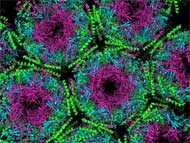 |
Infectious prions (short for proteinaceous infectious particles) are associated with some 20 different diseases in humans and
animals, including mad cow disease and a rare human form, Creutzfeldt-Jakob disease. All these diseases are untreatable and eventually fatal. Prions, which are composed solely of protein,
are classified by distinct strains, originally characterised by their incubation time and the disease they cause. Prions have the ability to reproduce, despite the fact that they contain no
nucleic acid genome. The evolutionary concept of quasi-species was first conceived by Manfred Eigen, a German biophysicist who won the Nobel Prize in Chemistry in 1967. Basically stated, a
quasi-species is a complex, self-perpetuating population of diverse and related entities that act as a whole. Bacteriophages, viruses that infect bacteria, are quasi-species. They
constantly create mutations and eliminate the unfavourable ones. In these quasi-populations, much like we have now found in prions, you begin with a single particle, but it becomes very
heterogeneous as it grows into a larger population. There are unknown dynamics at work in prions. Microscopic "holes" are
characteristic of prion-affected tissue sections, causing development of a "spongy" architecture. |
 |
There are two distinct facets of the body’s disengagement with the world after total brain
failure. One is utter lack of consciousness. Even the very compromised form of consciousness in vegetative patients - called by neurologists, somewhat problematically, "awakeness
without awareness" — is absent. The body with total brain failure never wakes up and fails the simplest tests of reactivity to pain, to light, to anything from the world outside. The 2nd
facet of the body’s disengagement is the complete loss of drive to breathe. This aspect is often brushed aside. Many are content to say either that breathing isn't absent in a body
connected to a ventilator or that the absence of the power to breathe is of little importance to interpreting a patient’s condition. Those who claim that a body with total brain failure still
breathes betray a deep misunderstanding of this crucial activity. Yes, the ventilator successfully bellows air in and out of the lungs. And true, oxygen from the air enters the bloodstream
and is carried out to body tissues. But these mechanical aspects of breathing are not the whole. Breathing is an activity of the whole organism, an action taken toward the world, spurred by
the organism’s felt need. The body of an animal needs what the world has to give and works constantly in its own interests to obtain it. This element of need-driven action must not be
forgotten when we evaluate the condition of total brain failure. If there is no sign of this need, no "air hunger" to disturb the stillness, this lends credence to the idea that death has indeed
come. When reliable evidence says that neither consciousness nor drive to breathe will ever return, the body can rightly be called a corpse. And if you want a dose of reality, Walter Schels
and Beate Lakotta have a photo series called "Life before Death" - portraits of 11
people taken shortly before and just after they died. The absence of life shows clearly. |
 |
At 104, Canterbury widow Ellen Noy still drives "little short runs" around her hometown
of Kaiapoi to go shopping or to play cards or croquet. With no power steering, parking can be difficult but her arms get a good workout, she says. "I've never had an accident or been picked
up by the police. They always say, when I go for a driving test, that I am a good driver." Mrs Noy says she values her independence and would be upset without her driver's
licence. Nearly 4,000 of the 3.2 million licensed drivers on New Zealand's roads are 90 or over - beginning life around the same time as Henry Ford's Model T entered production. Of those, 7
drivers are over 100, with the oldest being Mrs Noy. The numbers of senior drivers are
expected to increase rapidly over this decade. They have to renew their licences at age 75, 80 and then every 2 years after that. This includes a medical certificate confirming they're
safe to drive. If doctors have any concerns about seniors' driving, they can put restrictions on the medical certificate or refer patients for specialist assessments. In 2008, the driver
was aged 75 or older in just 4.4% of accidents resulting in injury or death. Unfortunately, the ability to drive safely is one that can disappear precipitously in the elderly. A knee can
lock on the accelerator, for instance. I'm glad that Ms Noy is still alert at 104, but I question the wisdom of having her behind the wheel. According to the National Highway Traffic Safety
Administration, the number of fatal crashes in which older drivers are involved is increasing. Elderly drivers don't deal as well as younger ones with complex traffic situations. Per mile
driven, drivers 75 years and older have higher rates of fatal motor vehicle crashes than drivers in other age groups except teenagers. Per licensed driver, fatal crash rates rise sharply at age
70 and older. At the very least elder drivers should avoid driving at night and should minimise the number of left-hand turns they have to make. This problem will only get worse as
baby-boomers age. See "Warning Signs: When to Begin to Limit Your Driving" if you're 75 or
older. |
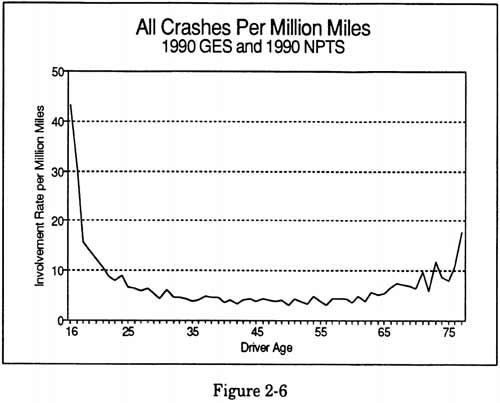
From "Analysis of Accident Rates by Age, Gender, and Time of Day Based on the
1990 Nationwide Personal Transportation Survey"
University of Michigan, Transportation Research Institute, February 1993, by Dawn L Massie and Kenneth L Campbell |
 |
In engineering or thought experiments, unobtainium is a humourous concept for any extremely rare, costly, or physically impossible
material needed to fulfil a given design for a given application. The properties of any particular unobtainium depend on the intended use. For example, a pulley made of unobtainium might be
massless and frictionless. However, if used in a nuclear rocket, unobtainium would be light, strong at high temperatures, and resistant to radiation damage. Another largely synonymous term
is wishalloy, although the sense is often subtly different in that a wishalloy usually doesn't exist at all, whereas unobtainium may merely be unavailable. The term handwavium can also be used to
indicate a material that probably cannot even in principle be real. Engineers have long (since at least the 1950s) used the term unobtainium when referring to unusual or costly materials, or when
theoretically considering a material perfect for their needs in all respects save that it doesn't exist. Similarly, in maintaining old equipment (electronic and other) unobtainium is often used
to refer to replacement parts that are no longer made (for example many parts for reel-to-reel audio recorders used to play back archive tapes, as for digitization). Uncommon, or rare, vacuum
tubes are often said to be made of unobtainium when they cost more than the equipment to which they are fitted. Unobtainium can also refer to any rare but desirable material used to motivate a
conflict over its possession, making it a type of MacGuffin. |
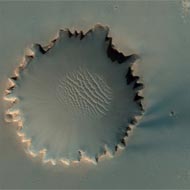 |
Since 2006, NASA's Mars Reconnaissance Orbiter (MRO) has been orbiting - well, Mars. It
currently circles approximately 300 kilometres (187 miles) above the Martian surface. There are 35 images here, some quite strange and/or spectacular. Though the one I selected isn't so
unusual, it has a special property to me - sometimes when I look at it, it seems to protrude and sometimes to be recessed. Whichever one it seems, I can't quite switch to the other way of
looking - yet the next time I view it (even if only a minute or two later), it may look completely different. I don't know why - it doesn't seem to affect anyone else here quite that
way. This is Victoria Crater at Meridiani Planum. The crater is approximately 800 metres (about half a mile) in diameter. Layered sedimentary rocks are exposed along the inner wall
of the crater and boulders that have fallen from the wall are visible on the crater floor. NASA's Mars rover Opportunity explored this crater and its walls in 2006. |
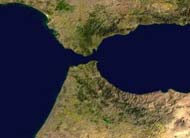 |
A flood of biblical proportions filled the present-day Mediterranean Sea in a matter of months. At its peak the
mega-flood caused the sea's level to rise by over 10 metres per day. Around 5.6 million years ago, the Mediterranean Sea almost completely evaporated when it became disconnected from the Atlantic
Ocean. This was due to uplift of the Strait of Gibraltar by tectonic activity, combined with a drop in sea level. Further tectonic activity 5.3 million years ago lowered the Strait and
reconnected the dry Mediterranean basin with the Atlantic. Previously it was assumed that it took at least a decade to refill the Mediterranean via a waterfall over the Strait. A new
analysis shows that the bulk of the water, an event known as the Zanclean flood, arrived in less than 2 years, pouring down a long, shallow ramp. It most likely started with a trickle of water
over a hard rock barrier, taking thousands of years. This gradually deepened the channel until the barrier failed and water surged through. Peak flow was around 1,000 times greater than the
present Amazon river at its highest rate (or more than 300,000,00 cubic metres per second). If the land connection had remained, this would've facilitated an earlier arrival of humans in western
Europe. Today, Africa is constantly moving north; long-term prognosis for the Mediterranean is not good - already it's gone from being an open ocean to, effectively, a lake. |
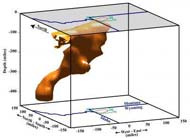 |
The plumbing that feeds the Yellowstone supervolcano is a plume of hot and molten rock rising at an angle
from the northwest at a depth of at least 410 miles and the banana-shaped magma chamber located a few miles beneath Yellowstone is 20% larger than once believed - so a future cataclysmic eruption
could be even larger than previously imagined. The same "hotspot" that feeds Yellowstone volcanism also triggered the Columbia River flood basalts that buried parts of Oregon, Washington state
and Idaho with lava millions of years ago. The plume angles downward across 150 miles to the west-northwest from Yellowstone, reaching a depth of from 410 to 620 miles. (The Hawaiian
hotspot which created the Hawaiian Islands is fed by a plume extending downward at least 930 miles, tilting southeast.) The Yellowstone hotspot, once located beneath the Oregon-Idaho-Nevada
border region, fed a plume of hot and molten rock that produced caldera eruptions - the largest kind. As North America slid southwest over the hotspot, the plume generated more than 140 huge
eruptions producing a chain of giant calderas extending northeast to the current site of Yellowstone National Park. There, huge caldera eruptions occurred 2 million, 1 million and 642,000 years
ago, each hundreds to thousands of times larger than the 1980 eruption of Mount St Helens, covering half the continental US with inches to feet of ash. The Yellowstone caldera is 40 miles by 25
miles, a remnant of the last giant eruption. Since 2004, this caldera floor has risen 3 inches per year, suggesting recharge of the magma body beneath it. |
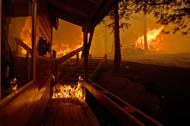 |
On the difficulty of being a fire photographer:
The worst thing about fire is not the heat - it's the dust. The road turns into cake
flour, and the dust is like powdered sugar. You get this dusting sand in your teeth just from the blowing embers. Every time you change lenses you have that getting into the
camera. It's not so much a problem with the lens, because you can wipe that off. It's getting it on the chip. Just one ember, landing in dry pine needles heaped at the foot of a
staircase, was all it took to incinerate this house during an October 2007 fire in Running Springs, California. To the right is the same view after the fire was
done. More photos. |
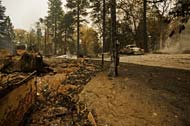 |
 |
Firefighters currently rely on modified Toyota Landcruisers or other utility vehicles for doing recon on hotspots. Those work well in a pinch for navigating rough terrain, but carry
only a meagre water supply of 500 litres and cannot survive a burnover when flames suddenly sweep over the area. The
proposed Amatoya gullwing firefighting all-terrain vehicle would use
aerogel-laminated insulation for its windows and body, and a temperature-controlled spraydown system which draws on a 400-litre auxiliary water tank specifically dedicated to that
purpose. Military-grade thermo ceramic paint would swell upon heat exposure and add some sacrificial protection. Its 1,800-litre water supply would power twin cannons that aim at hotspots
detected by a thermal imaging camera and directional spotlights. (No word, though, on what one might cost.) |
 |
"Dandelion" children — equivalent to our "normal" or healthy children, with resilient genes — do pretty well almost anywhere, whether raised in the equivalent of a sidewalk crack or a well-tended
garden. There are also “orchid” children, who will wilt if ignored or maltreated but bloom spectacularly with greenhouse
care. Having both dandelion and orchid kids greatly raises a family’s (and a species’) chances of
succeeding over time in any given environment. Dandelions in a population provide underlying stability. The less-numerous orchids, meanwhile, may falter in some environments but can
excel in those that suit them. And even when they lead troubled early lives, some of the resulting heightened responses to adversity that can be problematic in everyday life — increased
novelty-seeking, restlessness of attention, elevated risk-taking, or aggression — can prove advantageous in certain challenging situations: wars (tribal or modern), social strife of many kinds, and
migrations to new environments. Together, the steady dandelions and the mercurial orchids offer an adaptive flexibility that neither can provide alone. 1-to-3-year-olds who indulge heavily
in oppositional, aggressive, uncooperative, and aggravating behaviour that psychologists call "externalising": whining, screaming, whacking, throwing tantrums and objects and wilfully refusing
reasonable requests - are likely to become stressed, confused children who fail academically and socially in school and become antisocial and unusually aggressive adults. But teaching mothers to
better understand and respond to these children results in a notable dropoff in the incidence of bad behaviour. Those children who suffer most from bad environments also profit most from good
ones. |
 |
"My family and I were in Aruba for the last two weeks. Then, as we started packing for our return flight, news spread across One Happy Island (yes, that is Aruba's official motto - it's on the
license plates) that another lunatic had tried to blow up a plane. We were scheduled to fly the next day - not exactly an ideal time to be travelling back to the US from abroad (let alone from a
part of the kingdom of the Netherlands), but we figured it would at least be a safe day to travel. Anticipating that the TSA might have instituted some new rules overnight, we arrived at Queen
Beatrix Airport 4½ hours early. Some airlines weren't allowing carry-ons; Delta just made us put a red sticker on them (not sure how that was supposed to help, but we did as we were
told). We went through two Aruban X-ray stations and passed one bomb-sniffing dog handled by US TSA agents. Then came an announcement that boarding would start an hour before our scheduled
departure and that all passengers would be frisked and have their carry-ons searched. With all the searching and frisking, boarding took 2½ hours. Onboard, we learned of more new TSA rules
(for flights to the US originating abroad). Cut to my 2-year-old daughter screaming bloody
murder as the flight attendant yanks the pillow from under her head an hour before landing. Seriously." |
 |
Samual Mills Damon acquired the ahupua'a (uplands-to-sea tract) of Moanalua in 1884 from Princess Pauahi Bishop, whose husband was a
business partner of Damon. Before him, the lands belonged to the reigning House of Kalakaua. Damon was involved with the Committee of Safety that succeeded in the overthrow of the Kingdom
of Hawai'i and obtained the abdication of the Queen. His estate sold the property in 1956, but Damon had put part into a trust to became a public park, Moanalua Gardens. This is a monkey
pod tree in the park known as the Hitachi tree because Hitachi, Ltd has used it as their corporate symbol for decades (it
represents "synergy, growth and strength") and the $400,000 per year that that it now costs them defrays much of the park's annual expenses. |
|
 |
 |
 |
 |
The Christmas tree worm is aptly named because both its common and Latin names refer to the two
chromatically-hued spiral structures that are most commonly what is seen of the worm by divers. These "crowns" are actually highly modified prostomial palps which are specialised mouth
appendages of the worm. Each spiral is composed of feather-like tentacles called radioles, which are heavily ciliated. Any prey trapped in them are transported straight toward the
worm's mouth. While they are primarily feeding structures, S giganteus also uses its radioles for respiration.
It is because of this that the structures are commonly called "gills".
Christmas-tree worms are widely distributed throughout the world's tropical oceans. They have been known to occur from the Caribbean to the Indo-Pacific.
Photos by Nick Hobgood (East Timor), Mila Zinkova (Papua New Guinea), Richard Ling (Osprey Reef, Coral Sea), Gary Hughes (Okinawa, Japan) |
|
 |
China appears to be capitalising on America's trillion-dollar war campaign in Iraq and
Afghanistan. China has invested $3.4 billion in a copper-mining effort southeast of Kabul. It’s the largest foreign investment project in war-torn Afghanistan according to the New
York Times. And it’s hardly China’s only investment in an American battlefield. Earlier this month, a consortium led by China National Petroleum Company won an auction to develop
Iraq’s Halfiya oil field, which is believed to hold 4.1 billion barrels of black gold. CNPC already has the rights to develop Rumaila, Iraq’s largest oilfield, alongside BP, notes the Times of
London. It is also helping to restore production at al-Ahdab field. Sinopec, another Chinese oil group, has a strong position in northern Iraq, after its $7.9 billion acquisition of the
London-listed Addax Petroleum, which has been exploring for oil in the autonomous Kurdish region. |
 |
Since 1945, the US has regarded itself as the leader of the "free world". But the Obama administration is facing an unexpected and unwelcome development in global politics: 4 of the biggest and
most strategically important democracies in the developing world – Brazil, India, South Africa, Turkey – are increasingly at odds with American foreign policy and none can be counted as a reliable ally
either of the US or of a broader "community of democracies". Rather than siding with the US on big international issues, they may just line up with authoritarian powers such as China or
Iran. In Copenhagen, Brazil, South Africa and India decided that their status as developing nations was more important than their status as democracies. Like the Chinese, they argued that
it is fundamentally unjust to cap greenhouse gas emissions of poor countries at a lower level than the emissions of the US or the European Union - all the more so since the industrialised west is
responsible for the great bulk of the carbon dioxide already in the atmosphere. Revealingly, both Brazilian and Chinese leaders have made the same pointed joke – likening the US to a rich man
who, after gorging himself at a banquet, then invites the neighbours in for coffee and asks them to split the bill. Turkey, once regarded as a crucial American ally in the cold war and then
trumpeted as the only example of a secular, pro-western, Muslim democracy, is also no longer a reliable partner for the
west. Ever since the US-led invasion of Iraq, opinion polls there have shown very high levels
of anti-Americanism. The mildly Islamist AKP government has engaged with America’s regional enemies – including Hamas, Hizbollah and Iran – and alarmed the Americans by taking an increasingly
hostile attitude to Israel. |
 |
One of the enduring mysteries of the 2008 campaign was what got Ted Kennedy so mad at Bill Clinton. In
Game Change, John Heliemann and Mark Halperin report: The day after Iowa, Bill Clinton phoned Ted Kennedy and pressed for an endorsement of Hillary. But Bill then went on, belittling Obama
in a manner that deeply offended Kennedy. Recounting the conversation later to a friend, Teddy fumed that Clinton had said, "A few years ago, this guy would have been getting us
coffee." (My opinion of Clinton won't likely recover.) In looking for an illustration, I ran across an interesting comment: "Service by African-American waiters and Pullman porters was an
attraction of rail travel, for it allowed white passengers to enjoy the privileges of personal service and attention associated with wealth." Sad. |
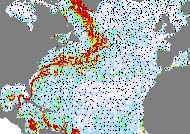 |
An unprecedented extreme in the northern hemisphere atmospheric circulation has driven a strong direct connecting current between the Gulf Stream and the West Greenland
current. The unprecedented negativity of the "Arctic Oscillation" and the strong connection of the Gulf Stream with the Greenland current are exceptional events, but most likely a natural
variation of weather and currents rather than global warming. Nevertheless, Great Britain is feeling the effects. |
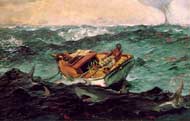 |
In trying to find more about climate and the Gulf stream, I stumbled upon a Kennesaw State University oceanography lecture page with unusual ocean-related artwork thumbnails. My favourite was the
one on the left, "The Gulf Stream", painted by Winslow Homer in 1899. Searching for more information about that painting led me to a site depicting 10 great seascapes (Homer's being one of
them). My favourite painting from that page is the one on the right by Ivan Aivazovsky called "The Ninth Wave", painted in 1850. |
 |
 |
In representing the emergence of the world’s languages as a curse of gibberish, the biblical tale of the Tower of Babel makes us moderns smile. Yet, considering the headache that 6,000 languages
can induce in real life, the story makes a certain sense. (However, only about 200 languages are truly written: most are spoken only.) Even with good instruction, it is fiendishly difficult
to learn any new language well, at least after about the age of 15. While vilified in certain quarters as threatening the future of the English language in America, most immigrants who actually
try to improve their English skills find that they have trouble communicating effectively even with doctors or their children’s schoolteachers. According to one estimate, 100 years from now the
6,000 languages used today will likely dwindle to 600. The question is whether this is a problem. The oft-heard claim that the death of a language means the death of a culture puts the cart
before the horse. When the culture dies, naturally the language dies along with it - but the reverse is not necessarily true. Native Americans would bristle at the idea that they are no
longer meaningfully "Indian" simply because they no longer speak their ancestral tongue.
At the end of the day, language death is a symptom of people coming together. Globalisation means hitherto isolated peoples migrating and sharing space. For them to do so and still
maintain distinct languages across generations happens only amidst unusually tenacious self-isolation — such as that of the Amish — or brutal segregation. Jews did not speak Yiddish in order to
revel in their diversity but because they lived in an apartheid society. |
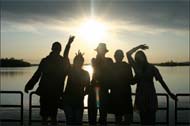 |
Psychologists have long been interested in what happens when people's internal drives
are replaced by external motivations. A host of experiments have shown that when threats and rewards enter the picture, they tend to destroy inner drives. Paycheques and pink slips
might be powerful reasons to get out of bed each day, but they turn out to be surprisingly ineffective and even counterproductive in getting people to perform at their best. Human beings both
want to - and, in a deeper way, need to - feel a sense of being autonomous. When someone else begins to seduce you into behaving with offer of a reward, it takes away your sense of being
autonomous. Now you're doing it for someone else. Beliefs about the utility of rewards and punishments in motivating human behaviour are deeply ingrained, yet more than 100 research
studies have shown that motivating people in this manner can have the unintentional effect of undermining intrinsic motivation - unless the task is mundane and reward is needed to get someone to do it
at all. |
 |
Carrying extra weight on your hips, bum and thighs is good for your health, protecting against heart and metabolic problems,
UK experts have said. Hip fat mops up harmful fatty acids and contains a natural anti-inflammatory agent that stops arteries clogging, a Nature publication has reported. Big behinds
are preferable to extra fat around the waistline, which gives no such protection. In the future, doctors might prescribe ways to redistribute body fat to the hips to protect against
cardiovascular and metabolic diseases such as diabetes. But unfortunately, pear-shaped women with big hips and thighs are
at higher risk of dangerous clots (deep vein thrombosis or a clot in the lung called pulmonary embolism), even if they have "ideal" body weight. It's always something. |
 |
The Horse Latitudes are an area in the Atlantic Ocean where the trade winds die, which stalled early Spanish ships sailing
to the New World. To lighten the ships, sailors threw heavy cargo overboard to allow the weak sails to pull the ship out of the doldrums. This included furniture, crates of dishes, and even
cannons. When particular areas were still too calm, they were forced to toss over their frightened horses into the sea. The legend is that the horses would swim after them for miles before
they drowned, and the superstitious sailors could hear the horses' screams in their haunted dreams for the rest of the voyage. Interesting side trivia: this weather phenomena occurs between 30 and
35 degrees north and south of the equator. The air often sinks in these regions and most of the major deserts around the world can be found in this band. Another (probably unrelated)
curiosity is that the Bermuda Triangle is also between these latitudes. (Unfortunately, I could find nothing about the painting at the left, but the 3 below are all by Danica Novgorodoff.) |

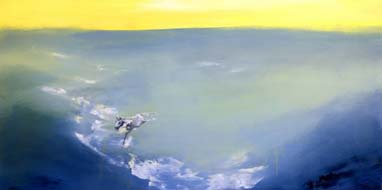
 |
  
Since I do not believe that there should be different recommendations for people living in the Bronx and people living in Manhattan,
I am uncomfortable making different recommendations for my patients in Boston and in Haiti.
- Paul Farmer

For other updates click "Home" (for the latest) or "Next" (for older) below
|
 Animals
Animals Animation
Animation Art of Playing Cards
Art of Playing Cards Drugs
Drugs Education
Education Environment
Environment Flying
Flying History
History Humour
Humour Immigration
Immigration Info/Tech
Info/Tech Intellectual/Entertaining
Intellectual/Entertaining Lifestyles
Lifestyles Men
Men Money/Politics/Law
Money/Politics/Law New Jersey
New Jersey Odds and Oddities
Odds and Oddities Older & Under
Older & Under Photography
Photography Prisons
Prisons Relationships
Relationships Science
Science Social/Cultural
Social/Cultural Terrorism
Terrorism Wellington
Wellington Working
Working Zero Return Investment
Zero Return Investment




